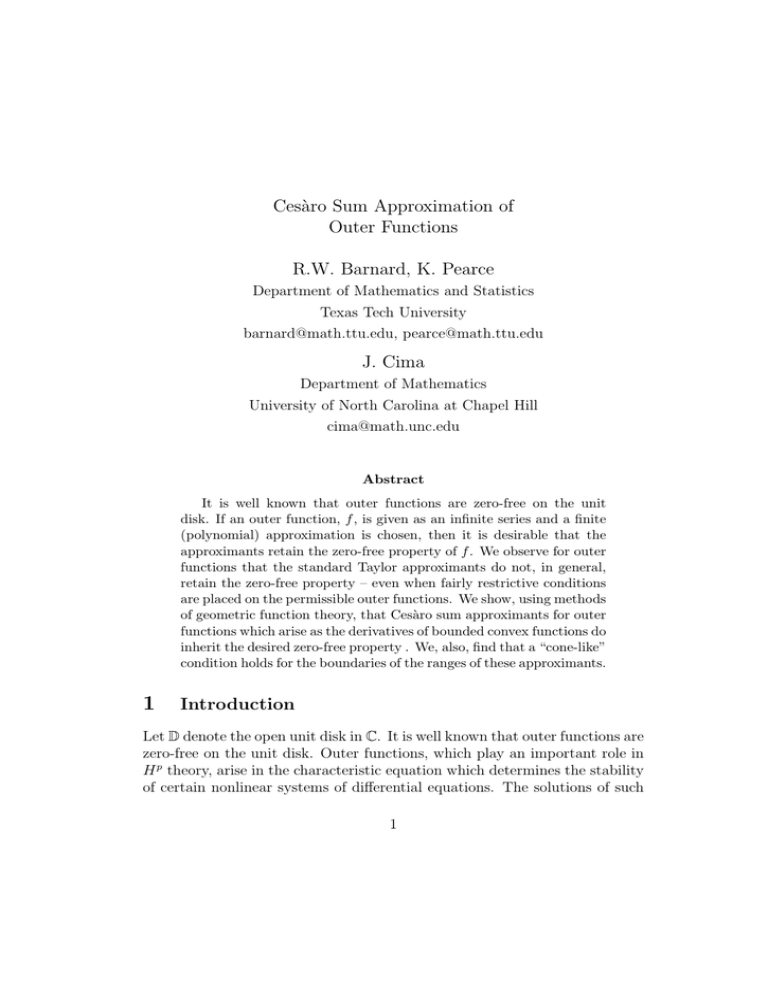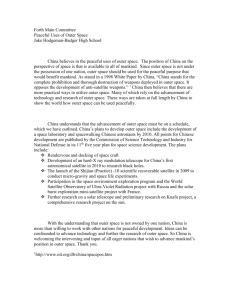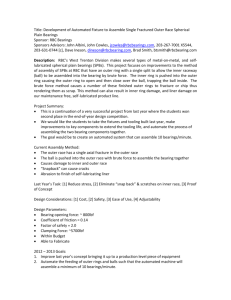Ces` aro Sum Approximation of Outer Functions R.W. Barnard, K. Pearce
advertisement

Cesàro Sum Approximation of
Outer Functions
R.W. Barnard, K. Pearce
Department of Mathematics and Statistics
Texas Tech University
barnard@math.ttu.edu, pearce@math.ttu.edu
J. Cima
Department of Mathematics
University of North Carolina at Chapel Hill
cima@math.unc.edu
Abstract
It is well known that outer functions are zero-free on the unit
disk. If an outer function, f , is given as an infinite series and a finite
(polynomial) approximation is chosen, then it is desirable that the
approximants retain the zero-free property of f . We observe for outer
functions that the standard Taylor approximants do not, in general,
retain the zero-free property – even when fairly restrictive conditions
are placed on the permissible outer functions. We show, using methods
of geometric function theory, that Cesàro sum approximants for outer
functions which arise as the derivatives of bounded convex functions do
inherit the desired zero-free property . We, also, find that a “cone-like”
condition holds for the boundaries of the ranges of these approximants.
1
Introduction
Let D denote the open unit disk in C. It is well known that outer functions are
zero-free on the unit disk. Outer functions, which play an important role in
H p theory, arise in the characteristic equation which determines the stability
of certain nonlinear systems of differential equations. The solutions of such
1
characteristic equations frequently involves ratios of the form h/f where f
is an outer function (see [Cu], p. 288). If f is given as an infinite series and
a finite (polynomial) approximation is chosen, then it is desirable, in order
to justify the choice of the approximant, that the zeros of the approximant
retain the zero-free property of f .
In this note we consider questions about when approximating sequences of
polynomials for outer functions inherit the zero-free property on D possessed
by outer functions. This leads to an investigation of the location of the zeros
and behavior of such approximating sequences of polynomials.
We show by examples that for outer functions the standard Taylor approximants do not, in general, retain the zero-free property. This is especially
the case for low order Taylor approximants, even when fairly restrictive conditions are placed on the permissible outer functions, such as requiring these
to be generated by Smirnov domains or requiring these to satisfy certain geometric conditions. The case for high order Taylor approximants to functions
analytic and non-vanishing on the closed unit disk is covered by Hurwitz’s
theorem which assures that for n, the degree of the approximant, sufficiently
large, that the Taylor approximant will be zero-free on D since the target,
the outer function, is zero-free on D. For practical purposes, however, the
n required above may be prohibitively large. Thus, we seek conditions on
outer functions and classes of approximants for which the zero-free property
on D will be inherited by all of the approximants.
Jentzsch’s classical results ([Di], p. 352) show that the circle of convergence for a Taylor series is a subset of the set of limit points of the zero
sets of the sequence of Taylor approximants. This suggests that, in general,
a careful analysis will be required in order to affirm the desired zero-free
inheritance.
We, thus, consider other approximants such as Cesàro sums. We find
that when considering geometric restrictions, such as convexity on Smirnov
domains, the methods of geometric function theory can be applied to verify
the desired zero-free inheritance for appropriate approximants. We, also, find
that a “cone-like” condition holds for the boundaries of the ranges of these
approximants.
2
Outer Functions
Recall that an outer function is a function f in H p of the form
2
1
f (z) = eiγ e 2π
1+eit z
−π 1−eit z
Rπ
log ψ(t)dt
(1)
where ψ(t) ≥ 0, log ψ(t) is in L1 and ψ(t) is in Lp . See [Du1] for the definitions
and classical properties of outer functions. Since any function f in H 1 which
has 1/f in H 1 is an outer function, then typical
examples of outer functions
Qn
can be generated by functions of the form k=1 (1−eiθk z)αk for −1 < αk < 1.
3
Taylor Approximants
We will look at some examples which show that the standard Taylor approximants are not necessarily zero-free
on D. Consider f (z) = (1+ei/10 z)1/2 /(1−
Pn
71/100
k
z)
P∞ . Ifk we let pn (z) = k=0 ak z be the Taylor approximant for f (z) =
k=0 ak z , then computer computations show that p3 has 1 zero inside D,
p4 has no zeros inside D and p5 again has a zero inside D. Thus, not only
do some of the pn ’s have zeros inside D, there is also no guarantee that once
they are zero-free on D, that they will remain so for higher orders.
Next, we show that even imposing restrictive geometric constraints on
the outer functions may not suffice to assure that their Taylor approximants
will inherit their zero-free property on D. A common and useful generation
for outer functions is found by considering Smirnov domains. See [Po] for
their definition and properties. We recall that if a simply connected domain
G with a rectifiable boundary is a Smirnov domain, then the conformal map
f , mapping D onto G, has the property that its derivative f 0 is an outer
function. Also, boundedness and convexity is a sufficient condition on a
domain to guarantee it to be a Smirnov domain. Thus, the derivatives of
bounded convex functions are always outer functions.
For r, 0 < r < 1, let fr (z) = z/(1−rz). Then, fr maps D onto a bounded
convex domain so that fr is an outer function. Since fr (z) = 1 + 2rz + ... it
is easy to see that many of its early Taylor approximants are not zero-free
on D for r near 1.
4
Cesàro Approximants
The previous observations suggest using different
approximants. We
P
Pnconsider
k
k
the Cesàro means for a function f (z) = ∞
a
z
.
Let
s
(z)
=
n
k=0 k P
k=0 ak z .
n
1
The Cesàro means σn are defined by σn (z) = n+1
k=0 sk (z). We note that
sn can be written as the linear combination
3
sn = (n + 1)σn − nσn−1 .
(2)
The proof of Jentzsch’s theorem ([Di], p.
p 352) can be modified to show
that if an assumption is made that lim sup n |σn (z)| ≤ 1 for some z outside
the circle of convergence, then a contradiction ensues. Specifically, for such
a z and
p for any ρ > 0 there exists an n(ρ) such that for n > n(ρ) we have
that j |σj (z)| ≤ (1 + ρ) forj = n − 1 and n. It follows from (2) that
|sn (z)| ≤ (n + 1)|σn (z)| + n|σn−1 (z)|
≤ (n + 1)(1 + ρ)n + n(1 + ρ)n−1 ≤ 2(n + 1)(1 + ρ)n .
(3)
p
Thus, lim sup |sn (z)| ≤ lim sup n 2(n + 1)(1 + ρ) = 1 + ρ. The arbitrariness of ρ implies that lim sup |sn (z)| ≤ 1, which contradicts a conclusion in
the proof of Jentzsch’s Theorem. Continuing as in the proof of Jentzsch’s
Theorem, it follows that the circle of convergence is also a subset of the limit
set of the zeros of {σn }.
We now consider the Cesàro approximants of outer functions which are
the derivatives of a convex functions. We introduce the following notation
(see [Du2]). Let
A = {f : f (z) = a0 + a1 z + a2 z 2 + ..., f is analytic on D},
S = {f ∈ A : f (0) = 0, f (0) = 1, f is univalent on D},
K = {f ∈ S : f is close-to-convex },
S ∗ = {f ∈ S : f is starlike w.r.t. 0},
C = {f ∈ S : f is convex}.
We note Kaplan’s relationship that f ∈ K if and only if there exists a
g ∈ S ∗ such that zf (z) = g(z)p(z) for some p ∈ A such that p(0) = 1 and
p(D) lies in a half plane H with 0 ∈ ∂H. Also, we note that close-to-convexity
and convexity are geometric conditions on a domain which are independent
of the normalization of an associated function mapping D onto the domain.
For f, g ∈ A with f (z) = a0 +a1 z +a2 z 2 +... and g(z) = b0 +b1 z +b2 z 2 +...,
define f ∗g by f ∗g(z) = a0 b0 +a1 b1 z+a2 b2 z 2 +... , i.e., f ∗g is the (Hadamard)
convolution of f and g. We note that we will employ, in the arguments we
give, a common abuse of notation which interchanges the function f ∗ g
with the function values f (z) ∗ g(z). The two major Sheil-Small-Ruscheweyh
results (see [Du2], Section 8.3) state that
4
(A) if f ∈ C and g ∈ S ∗ , then f ∗ g ∈ S ∗ and
(B) if f ∈ C and g ∈ S ∗ , p ∈ A with p(0) = 1, then f ∗ gp = (f ∗ g)p1
where p1 (D) ⊂ closed convex hull of p(D).
Let hP∈ A with h(z) = a0 + a1 z + a2 z 2 + .... From the partial sums
sn (z) = nk=0 ak z k we can construct the Cesàro means σn of h by
n
1 X
σn (z) =
sk (z)
n + 1 k=0
= h(z) ∗
n
X
n−k+1
k=0
n+1
z k = h ∗ gn (z)
(4)
Pn
where gn (z) = k=0 n−k+1
z k . Note that gn is the Cesàro mean of the identity
n+1
function w.r.t. convolution, i.e., z/(1 − z).
We have now
Proposition 1 Let f ∈ A be such that f (D) is convex. Then, the Cesàro
means σn of f 0 are zero-free on D for all n. In particular, if f (D) is a bounded
convex domain, then for the outer function f 0 we have that the Cesàro means
σn are zero-free on D for all n.
Proof: Let h = f 0 . Let k be defined by k(z) = z/(1 − z)2 and note that
zf 0 (z) = k ∗ f (z). Then,
zf 0 (z) ∗ zgn (z)
z
f (z) ∗ k(z) ∗ zgn (z)
f (z) ∗ z(zgn (z))0
=
=
.
z
z
σn (z) = h ∗ gn (z) = f 0 ∗ gn (z) =
(5)
If it can be shown that zgn ∈ K, then applying (A) and using Kaplan’s
relationship would yield a g ∈ S ∗ and a p [with p(0) = 1 and p(D) lying in a
half plane H with 0 ∈ ∂H] such that
f (z) ∗ z(zgn (z))0
f ∗ gp(z)
(f ∗ g(z))p1 (z)
=
=
6= 0
z
z
z
since p1 (z) 6= 0 [since p1 (D) ⊂ H] and f ∗ g ∈ S ∗ is 0 only for z = 0.
J. Lewis’s ([Le], Lemma 3, p. 1118) result on Jacobi polynomials implies
that zgn ∈ K. An alternate approach to this can be made by noting that
5
Egervary [Eg] showed that Gn (z) = zgn (z) is starlike w.r.t. Gn (1). Since
another characterization of K is that f ∈ K if and only if the complement of
f (D), C\f (D), can be written as the union of non-intersecting half-rays, then
the fact that Gn (D) is starlike with respect to Gn (1) implies that C\Gn (D)
is the union of half-rays emanating from Gn (1).
5
Cone Condition
We now show that the ranges of the Cesàro approximants satisfy a cone-like
condition on the boundary. We will recall the following additional notation
from geometric function theory. Let
P = {p ∈ A : p(0) = 1, Re p(z) > 0 for z ∈ D},
P (1/2) = {p ∈ P : Re p(z) > 1/2 for z ∈ D},
S ∗ (α) = {f ∈ S ∗ : Re zf 0 (z)/f (z) > α for z ∈ D}.
Recall (see [Du2]) that h ∈ C implies that h(z)/z ∈ P (1/2) and zh0 (z)/h(z) ∈
P (1/2). Ruscheweyh ([Ru], p. 55) has generalized the principal results (A)
and (B) on convolution to show
(C) if f, g ∈ S ∗ (1/2), p ∈ A with p(0) = 1, then f ∗ gp = (f ∗ g)p1
where p1 (D) ⊂ closed convex hull of p(D).
Note (C) also implies that f ∗ g ∈ S ∗ (1/2).
We have then
Proposition 2 Let f ∈ A such that f (D) is convex and f (z) = a1 z + a2 z 2 +
(2)
..., a1 6= 0. Then, the Cesàro means σn of f 0 of order 2 have their ranges
contained in a cone (from 0) with opening 2βn π, where βn < 1.
Proof: We may assume that a1 = 1, otherwise apply the argument to
f (z)/a1 .
First, note that for the function f the Cesàro means of f 0 of order γ can
(γ)
be given by (see [Ru], p. 142]) f ∗ gn where
n−k+γ
n
X
n−k
zk
gn(γ) (z) =
n+γ
k=0
n
.
6
(γ)
(γ)
In Egervary’s notation sn−1 = zgn . Egervary proved for each n ≥ 1
(1)
(1)
(a) sn (D) is starlike w.r.t. sn (1),
(2)
(b) sn ∈ S ∗ (1/2),
(3)
(c) sn ∈ C.
We will use (b) as follows to yield the cone condition on the ranges
(γ)
f ∗ gn (D). Suppose f ∈ C ⊂ S ∗ (1/2). Then, using (b) and (C) we have
(2)
0
f ∗
gn(2)
(2)
zf 0 (z) ∗ zgn (z)
f (z) ∗ z(zgn (z))0
=
=
z
z
f (z) ∗
=
(2)
(2)
zgn z(zgn (z))0
(2)
zgn
z
(2)
f (z) ∗ zgn (z)
=
p1 (z)
z
(6)
(2)
where p1 ∈ P (1/2) and f (z) ∗ zgn (z) ∈ S ∗ (1/2). By a result of Brickman,
(2)
(2)
et al., [BHMW] we have f (z)∗zgz n (z) ∈ P (1/2). Since (f (z) ∗ zgn )/z is a
polynomial it is bounded, hence there exists β1 < 1 such that
(2)
βπ
f
(z)
∗
zg
(z)
n
1
.
arg
<
z
2
Hence, we have
(2)
f
(z)
∗
zg
(z)
n
arg f 0 (z) ∗ gn(2) (z) = arg
.p1 (z)
z
(2)
f (z) ∗ zgn (z) ≤ arg
+ | arg p1 (z)|
z
π π
≤ β1 + = βπ.
2
2
(7)
(8)
(2)
Since a subordination argument can be made to show that f (z)∗zgz n (z) ≺
(3)
gn (z), then β1 can be chosen independently of f .
We note that the above conclusion is valid for f ∈ S ∗ (1/2) and that it is
(2)
not generally extendable to f ∈ S ∗ , since k 0 (z) ∗ gn does not satisfy a cone
condition and k ∈ S ∗ .
7
References
[BHMW] L. Brickman, D.J. Hallenbeck, T. MacGregor and D.R. Wilken,
“Convex hulls and extreme points of families of starlike and convex mappings,” Trans. Amer. Math Soc. 185 (1973), 413-428.
[Cu] W.J. Cunningham, Introduction to Nonlinear Analysis, McGraw-Hill,
New York, 1958.
[Di] P. Dienes, The Taylor Series, Dover, New York, 1957.
[Du1] P. Duren, Theory of H p Spaces, Academic Press, New York, 1970.
[Du2] P. Duren, Univalent Functions, Springer-Verlag, New York, 1983.
[Eg] E. Egervary, “Abbildungseigenschaften der arithmetischen Mittle der
geometrischen Reihen,” Math. Z. 42 (1937), 221-230.
[Le] J.L. Lewis, “Applications of a convolution theorem to Jacobi polynomials,” SIAM J. Math. Anal. 10 (1979), 1110-1120.
[Po] C. Pommerenke, Boundary Behavior of Conformal Maps, SpringerVerlag, New York, 1972.
[Ru] S. Ruscheweyh, Convolutions in Geometric Function Theory, Sem.
Math. Sup., University of Monteral Press, 83 (1982).
8








